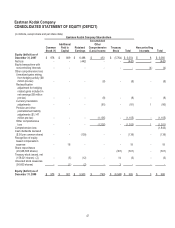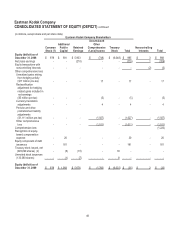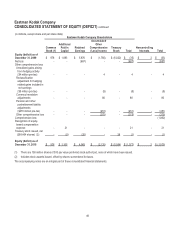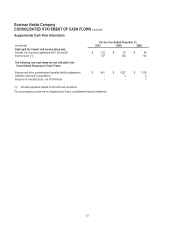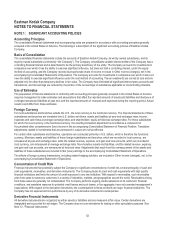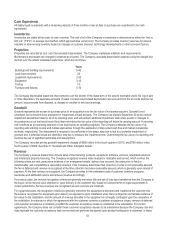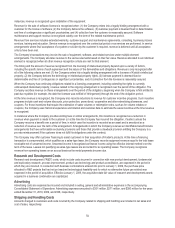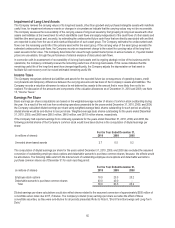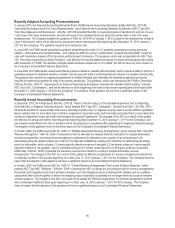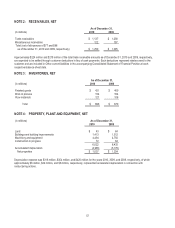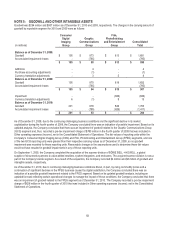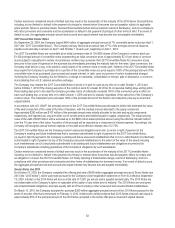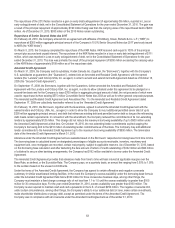Kodak 2010 Annual Report Download - page 56
Download and view the complete annual report
Please find page 56 of the 2010 Kodak annual report below. You can navigate through the pages in the report by either clicking on the pages listed below, or by using the keyword search tool below to find specific information within the annual report.54
instances, revenue is recognized upon installation of the equipment.
Revenue for the sale of software licenses is recognized when: (1) the Company enters into a legally binding arrangement with a
customer for the license of software; (2) the Company delivers the software; (3) customer payment is deemed fixed or determinable
and free of contingencies or significant uncertainties; and (4) collection from the customer is reasonably assured. Software
maintenance and support revenue is recognized ratably over the term of the related maintenance period.
Revenue from services includes extended warranty, customer support and maintenance agreements, consulting, business process
services, training and education. Service revenue is recognized over the contractual period or as services are performed. In service
arrangements where final acceptance of a system or solution by the customer is required, revenue is deferred until all acceptance
criteria have been met.
The Company's transactions may involve the sale of equipment, software, and related services under multiple element
arrangements. The Company allocates revenue to the various elements based on their fair value. Revenue allocated to an individual
element is recognized when all other revenue recognition criteria are met for that element.
The timing and the amount of revenue recognized from the licensing of intellectual property depend upon a variety of factors,
including the specific terms of each agreement and the nature of the deliverables and obligations. Revenue is only recognized after
all of the following criteria are met: (1) the Company enters into a legally binding arrangement with a licensee of Kodak’s intellectual
property, (2) the Company delivers the technology or intellectual property rights, (3) licensee payment is deemed fixed or
determinable and free of contingencies or significant uncertainties, and (4) collection from the licensee is reasonably assured.
When the Company has continuing obligations related to a licensing arrangement, including extending the rights to currently
undeveloped intellectual property, revenue related to the ongoing arrangement is recognized over the period of the obligation. The
Company ascribes revenue on these arrangements over the period of the obligation, beginning when the Company is first entitled to
past due royalties (for example, the date the licensee was notified of infringement) through the end of the obligation period.
At the time revenue is recognized, the Company also records reductions to revenue for customer incentive programs. Such incentive
programs include cash and volume discounts, price protection, promotional, cooperative and other advertising allowances, and
coupons. For those incentives that require the estimation of sales volumes or redemption rates, such as for volume rebates or
coupons, the Company uses historical experience and internal and customer data to estimate the sales incentive at the time revenue
is recognized.
In instances where the Company provides slotting fees or similar arrangements, this incentive is recognized as a reduction in
revenue when payment is made to the customer (or at the time the Company has incurred the obligation, if earlier) unless the
Company receives a benefit over a period of time, in which case the incentive is recorded as an asset and is amortized as a
reduction of revenue over the term of the arrangement. Arrangements in which the Company receives an identifiable benefit include
arrangements that have enforceable exclusivity provisions and those that provide a clawback provision entitling the Company to a
pro rata reimbursement if the customer does not fulfill its obligations under the contract.
The Company may offer customer financing to assist customers in their acquisition of Kodak’s products. At the time a financing
transaction is consummated, which qualifies as a sales-type lease, the Company records equipment revenue equal to the total lease
receivable net of unearned income. Unearned income is recognized as finance income using the effective interest method over the
term of the lease. Leases not qualifying as sales-type leases are accounted for as operating leases. The Company recognizes
revenue from operating leases on an accrual basis as the rental payments become due.
Research and Development Costs
Research and development (“R&D”) costs, which include costs incurred in connection with new product development, fundamental
and exploratory research, process improvement, product use technology and product accreditation, are expensed in the period in
which they are incurred. In connection with business combinations entered into prior to January 1, 2009, the purchase price
allocated to R&D projects that had not yet reached technological feasibility and for which no alternative future use existed was
expensed in the period of acquisition. Effective January 1, 2009, the acquisition-date fair value of research and development assets
acquired in a business combination are capitalized.
Advertising
Advertising costs are expensed as incurred and included in selling, general and administrative expenses in the accompanying
Consolidated Statement of Operations. Advertising expenses amounted to $301 million, $271 million, and $350 million for the years
ended December 31, 2010, 2009, and 2008, respectively.
Shipping and Handling Costs
Amounts charged to customers and costs incurred by the Company related to shipping and handling are included in net sales and
cost of sales, respectively.





